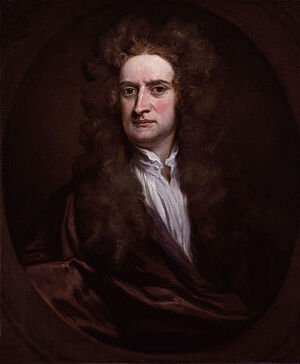Isaac Newton (nonfiction): Difference between revisions
No edit summary |
No edit summary |
||
| (6 intermediate revisions by the same user not shown) | |||
| Line 7: | Line 7: | ||
On October 2, 1667, Newton became a fellow at Trinity College, Cambridge. He had earned his bachelor's degree in 1665 and then spent two years at home in Lincolnshire inventing much of differential and integral calculus while Cambridge was closed due to plague. | On October 2, 1667, Newton became a fellow at Trinity College, Cambridge. He had earned his bachelor's degree in 1665 and then spent two years at home in Lincolnshire inventing much of differential and integral calculus while Cambridge was closed due to plague. | ||
On October 24,1676, Newton summarized the state of development of his method of fluxions and power series in the "Epistola posterior," which he sent to Oldenburg to transmit to Leibniz. | On October 24,1676, Newton summarized the state of development of his method of fluxions and power series in the "Epistola posterior," which he sent to Oldenburg to transmit to [[Gottfried Wilhelm Leibniz (nonfiction)|Leibniz]]. | ||
On December 10, 1684: Newton's derivation of [[Johannes Kepler (nonfiction)|Johannes Kepler]]'s laws from his theory of gravity, contained in the paper ''De motu corporum in gyrum'', is read to the Royal Society by [[Edmond Halley (nonfiction)|Edmond Halley]]. | |||
== In the News == | == In the News == | ||
| Line 17: | Line 19: | ||
* [[Gnomon algorithm]] | * [[Gnomon algorithm]] | ||
* [[Gnomon Chronicles]] | |||
* [[Mathematician]] | |||
* [[Mathematics]] | * [[Mathematics]] | ||
* ''[[Neutonianismo]]'' - a group of various folk dances characterized by a fast upbeat tempo, usually in 6/8 time (sometimes 12/8 or 4/4), accompanied by tambourines, related to ''[[Tarantella (nonfiction)|tarantella]]''. ''Neutonianismo'' is popularly associated with a supposed dancing mania caused by the physics of Sir Isaac Newton, similar to the tarantella's association with dancing mania caused by spider bites. | |||
== Nonfiction cross-reference == | == Nonfiction cross-reference == | ||
* [[Calculus (nonfiction)]] | * [[Calculus (nonfiction)]] | ||
* [[Edmond Halley (nonfiction)]] | |||
* [[Johannes Kepler (nonfiction)]] | |||
* [[Gottfried Leibniz (nonfiction)]] | * [[Gottfried Leibniz (nonfiction)]] | ||
* [[Hypotheses non fingo (nonfiction)]] | * [[Hypotheses non fingo (nonfiction)]] | ||
| Line 29: | Line 36: | ||
* [[Physics (nonfiction)]] | * [[Physics (nonfiction)]] | ||
External links | == External links == | ||
* [https://twitter.com/GnomonChronicl1/status/1373262955488350208 Post] @ Twitter (death) | |||
* [https://www.facebook.com/karl.gregory.jones/posts/10225596609600662 Post] @ Facebook (death) | |||
* [https://en.wikipedia.org/wiki/Isaac_Newton Isaac Newton] @ Wikipedia | * [https://en.wikipedia.org/wiki/Isaac_Newton Isaac Newton] @ Wikipedia | ||
[[Category:Nonfiction (nonfiction)]] | [[Category:Nonfiction (nonfiction)]] | ||
[[Category:Color theorists (nonfiction)]] | |||
[[Category:Mathematicians (nonfiction)]] | [[Category:Mathematicians (nonfiction)]] | ||
[[Category:People (nonfiction)]] | [[Category:People (nonfiction)]] | ||
[[Category:Physicists (nonfiction)]] | [[Category:Physicists (nonfiction)]] | ||
Latest revision as of 07:25, 20 March 2021
Sir Isaac Newton FRS (25 December 1642 – 20 March 1726/27) was an English physicist and mathematician (described in his own day as a "natural philosopher") who is widely recognised as one of the most influential scientists of all time and a key figure in the scientific revolution.
His book Philosophiæ Naturalis Principia Mathematica ("Mathematical Principles of Natural Philosophy"), first published July 5, 1687, laid the foundations for classical mechanics.
Newton made seminal contributions to optics, and he shares credit with Gottfried Leibniz for the development of calculus.
On October 2, 1667, Newton became a fellow at Trinity College, Cambridge. He had earned his bachelor's degree in 1665 and then spent two years at home in Lincolnshire inventing much of differential and integral calculus while Cambridge was closed due to plague.
On October 24,1676, Newton summarized the state of development of his method of fluxions and power series in the "Epistola posterior," which he sent to Oldenburg to transmit to Leibniz.
On December 10, 1684: Newton's derivation of Johannes Kepler's laws from his theory of gravity, contained in the paper De motu corporum in gyrum, is read to the Royal Society by Edmond Halley.
In the News
Fiction cross-reference
- Gnomon algorithm
- Gnomon Chronicles
- Mathematician
- Mathematics
- Neutonianismo - a group of various folk dances characterized by a fast upbeat tempo, usually in 6/8 time (sometimes 12/8 or 4/4), accompanied by tambourines, related to tarantella. Neutonianismo is popularly associated with a supposed dancing mania caused by the physics of Sir Isaac Newton, similar to the tarantella's association with dancing mania caused by spider bites.
Nonfiction cross-reference
- Calculus (nonfiction)
- Edmond Halley (nonfiction)
- Johannes Kepler (nonfiction)
- Gottfried Leibniz (nonfiction)
- Hypotheses non fingo (nonfiction)
- Gottfried Wilhelm Leibniz (nonfiction)
- Newton's method (nonfiction)
- Mathematics (nonfiction)
- Physics (nonfiction)
External links
- Post @ Twitter (death)
- Post @ Facebook (death)
- Isaac Newton @ Wikipedia
